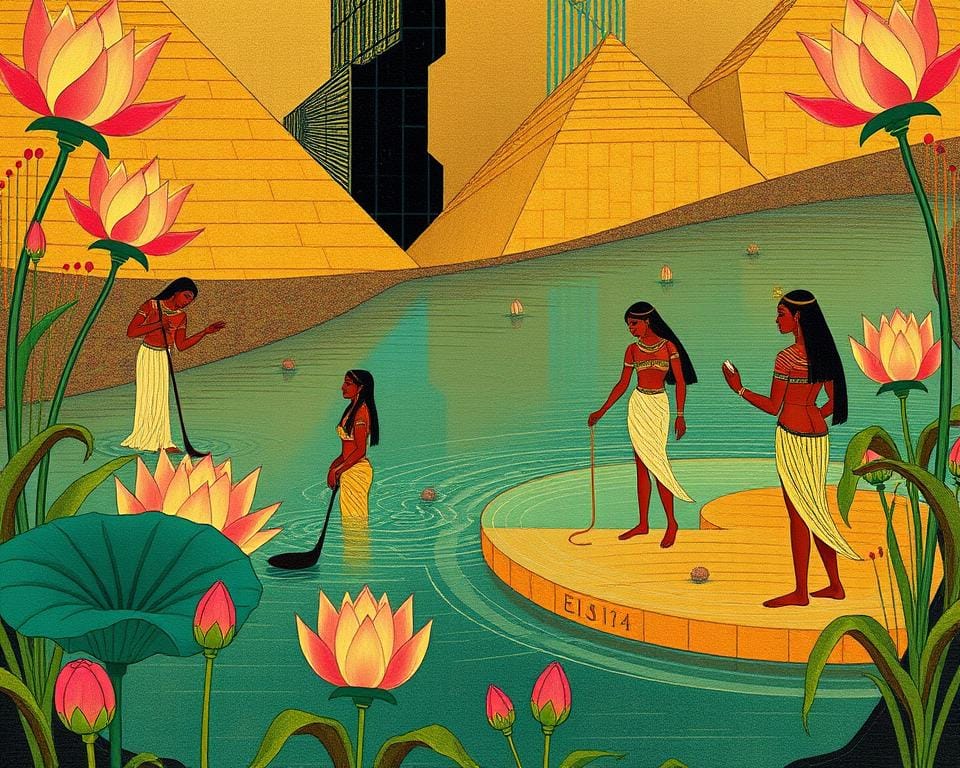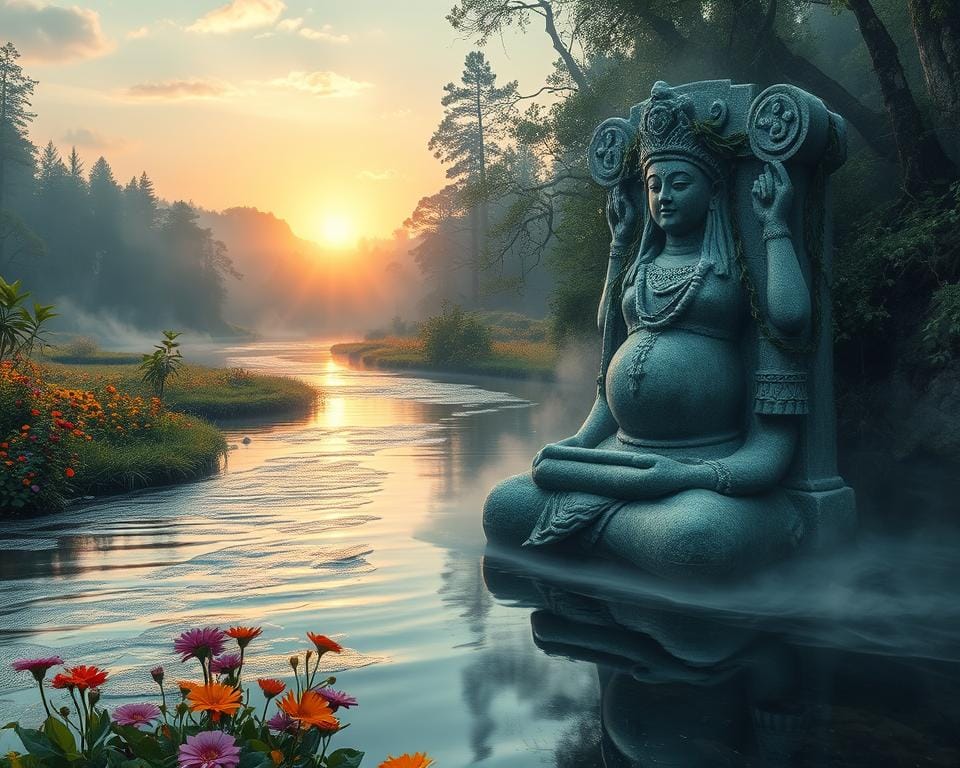Water’s role in art is significant and wide-reaching. It is known as a symbol of life, cleanliness, new beginnings, and feelings. Across history and cultures, its depiction stands for universal themes of human experience. Water symbolism is crucial, from ancient societies honoring rivers to modern art focusing on nature’s plight.
In art, water symbols are everywhere. They show its constant presence and its many meanings. The Nile in Egyptian art or cleansing rituals in faiths show this. Let’s dive into how water shapes art. We’ll see its power in showing change, personal development, and the fight to protect our environment.
Historical Significance of Water Symbolism in Art
Water symbolism has been key in art throughout history. It ranges from ancient times to the Renaissance. Artists have shown water in many important and varied ways.
Ancient Civilizations and Water Symbolism
Water was very meaningful in ancient cultures. The Mesopotamians saw water as a sign of cleansing and starting anew. The Nile River was seen as a symbol of new life and growth in Ancient Egypt, important for their agriculture. These examples show water’s deep importance in early societies. You can read more about ancient water symbolism and its impact.
Religious Practices and Artistic Depictions
Water imagery plays a big role in many religions. Christianity uses baptism to symbolize washing away the past and beginning again. In Hinduism, water in rituals stands for spiritual purity and renewal. This shows how water imagery connects across various beliefs and cultures.
Medieval and Renaissance Interpretations

In the medieval and Renaissance eras, water symbolism mixed with art and religion. It often showed ideas of purity and divine grace. Renaissance artists like Leonardo da Vinci put water in their art to add depth and realism. They included themes of starting anew and the beauty of nature. These works show how water symbolism’s meaning grew and changed in art.
Cultural Interpretations of Water in Various Art Forms
Water is a symbol in many art forms, showing life, change, and cleanliness. We will look at how Egyptian art, Native American beliefs, and Asian art view water.
Egyptian Art and the Nile
For Egyptians, the Nile was more than a river; it was crucial for life. Its floods meant fertility and new beginnings, inspiring lots of art. This link between the Nile and Egyptian art showed both support and a heavenly gift.

Art often celebrated the Nile’s role in farming abundance. Egyptian tombs showed fishing, boating, and farming by the Nile. Scenes with the river god Hapy, the flood deity, were common. These images showed the river’s material and spiritual roles.
Native American Symbolism and Sacred Springs
Native American cultures deeply respect water, with sacred springs being very important. These springs are linked to healing and spiritual cleaning. Their art includes detailed designs to show these springs’ holiness and importance in rituals.
This respect for water appears in pottery, carvings, and weavings. Tribes saw water as vital, with powers to clean and change. Springs were spiritual places, homes to spirits and ancestors.
Asian Art: The Ganges and Japanese Purification
In Hindu and Japanese traditions, water is very important. The Ganges River is sacred in Indian art, showing devotion and spiritual cleaning. Bathing in the Ganges is believed to purify the soul and erase sins, a theme in art about river rituals and festivals.
Japanese art often shows purification rituals with waterfalls and streams, symbolizing cleanliness. This shows the importance of water in Asian views of spiritual purity and starting fresh.
Both cultures use water in art to attract and hold the viewer’s attention, adding depth and meaning. By putting water elements strategically, art connects with ancient beliefs still important today.
To learn more about how water distillation supports these artistic traditions, you may visit this link.
Spiritual and Mythological Meanings in Art
Water in art is not just shown as it looks. It has spiritual symbols and myths too. This idea is seen in many cultures and times. It includes different beliefs and art styles.
Water as Purification and Rebirth
In many spiritual traditions, water is a symbol of cleaning and new beginnings. It’s a key part of rituals that mean a clean slate. For example, Christian baptisms use water to symbolize a new spiritual life.
The River Ganges in Hindu mythology is seen as a purifier, shown in art during religious events. Rivers in general are seen as cleaners in myths around the world. This shows a shared respect for water as a changer.
Ritual purification through water is both a physical and spiritual renewal shown in art.
Mythological Figures and Water Deities
In art, water gods are important, showing different meanings of water. Poseidon from Greek myths shows the sea’s power. He’s shown controlling the sea or with his trident.
In Hindu art, Ganga is the goddess of the Ganges River, showing purity and the divine. The cosmic ocean ‘Samudra’ in Hindu stories talks about life’s start. These show water’s spiritual and mythic roles.
The Well of Urd in Norse myths is a wisdom and fate source. Mimir’s Well also values knowledge, tied to water. This shows water’s deep links in art.
African tales have gods like Oshun, for fertility, love, and wealth. Mami Wata spirits add to water’s meaning in their culture.
Water is a global sign of life, purity, wisdom, strength, and change. It represents big and everyday things. Art shows our deep tie with water through history.
Water Symbolism in Art: Influence on Modern and Contemporary Art
Water symbolism has a rich history and continues to inspire modern art. Artists today use water motifs to talk about society and the environment. Their work shows us new ways to think about these important issues.
Antony Gormley’s Another Place on Crosby Beach is a standout example. It features 100 iron statues along 3.2 km of coast. These figures face the ocean, showing our ongoing conversation with the natural world and our inner thoughts.
In the art world now, water can represent our personal and shared identities. Rose-Lynn Fisher’s Topography of Tears looks closely at the makeup of human tears. Her project turns our feelings into something you can see under a microscope.
Artists also focus on environmental issues today. Andreas Franke’s SinkingWorld is an art show under the sea. It’s set 35 meters down on the Vandenberg shipwreck. Every year, 10,000 divers see it, highlighting water pollution and the need to protect our oceans.
Yayoi Kusama’s Fireflies on the Water shows water in a modern way. Her art, selling for millions, talks about life’s endless cycle. It reflects on water’s history and how it fits into current discussions.
The growth of water symbolism connects the past with today’s environmental themes in art. This link shows how water has always been key in art and thought. It merges age-old ideas with fresh, urgent stories.
The blend of historic meanings and current environmental issues is clear in today’s art. Even as artists’ methods change, water’s symbolic importance stays strong in our stories.
Conclusion
Exploring the impact of water symbolism in art shows how deeply cultures connect with water. Ancient civilizations along the Nile and Ganges saw rivers as sacred. They linked water to gods and spiritual rites. In Hindu stories, the Ganges is a sacred cleanser. Norse tales tell of Mimir’s Well, a symbol of wisdom gained through sacrifice.
Japanese Shinto spirituality highlights water in purification rituals, much like the Nile’s role in Egypt. In African beliefs, water spirits like Oshun symbolize fertility and wealth. These examples show water as a reflection of a society’s values and existential concerns.
Art makes us think about water’s role in our lives. It reveals water’s meanings through literature and symbolism in religious and philosophical traditions. Water’s image crosses cultures and time. This artistic view encourages us to value our bond with water. It stresses the importance of protecting this essential resource for the future.

